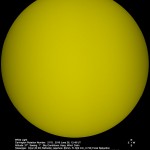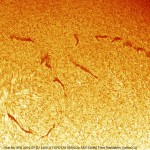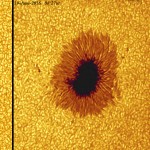July 18, 2016
Scanning Recommendation for Solar Drawings
Recent questions about what format drawings should be in when submitted to the Solar Archive, prompt us to write this post. Despite that many say that they want the highest quality and thus scans should be submitted in the highest possible resolution, this does not make a lot of sense. Drawings are made typically by pencil or a marker. In addition, the drawing should as accurately reflect what someone saw and document this accordingly. Think of it as this way: If you scan at 200 dpi (dots per inch) this means that the scanner will create a dot if it finds a line that is 1/200 of an inch or 1/8 of 1mm. So the question becomes can you draw features on a Solar disc and accurately position it to that scale? Without any further aid probably not. In addition, images are mostly available in the jpg format. This standard format allows a compression grade of 1 to 12 for the file data in the image, so the file becomes smaller in size. A full 8 1/2 by 11 sheet could take up 7 MB or larger when uncompressed, but compressed it might be only 250 – 300 kB. This is a huge difference if images need to be downloaded or processed.
So let’s take a look at how a PC does display images and data. A typical PC monitor is approx. 1250 pixels wide. Some are wider and others have less pixels available. So if you were to display the width of an 8 ½ x 11” paper across the width of the screen you would have 1250 pixels available and the screen is probably 13 to 15 inch wide. This would mean that if the page was displayed across the width of the entire screen, it displays at approx. 1 ½ times the size of the real sheet of paper and it would be displayed at a resolution of 1250/8 ½ or approx. 150 pixels per inch. This would be the optimum resolution for that screen to display that page. Images captured with the current technology also have a similar resolution of 1200 -1800 pixels wide. So increasing the resolution only makes the image bigger resulting in only a portion of that image being displayed on the screen and does not necessarily increase the clearness of what you did draw.
We have taken a good look at what the best format for our purpose is, and we have concluded the following: A scan with 150 to 200 dpi produces sufficient data to properly represent what’s on the paper you scanned for analysis, as well as reproduction in printed form. In addition, when the image is saved in the form of a jpg, a compression grade of 5 to 6 for the data compression, retains more than sufficient data to properly reconstruct what was scanned. This compression grade number is displayed in many programs when the file is saved as a jpg file, including Photoshop CS or PS Elements. So to summarize, for images to be submitted in our archive we prefer if you can scan drawings as follows:
Scan with 150 to 200 dpi.
Use jpg compression grade at 5 to 6 when saving the file.
This should produce files of reasonable size for on-line access. Remember, there are still many individuals who like to see your images, but they also have to deal with slow internet, or even dial up speeds.
Thanks for your consideration, and if you have any further questions or suggestions, please do not hesitate to send your question/suggestion to solarimages@alpo-astronomy.org .
Clear Skies,
The Solar Team.







